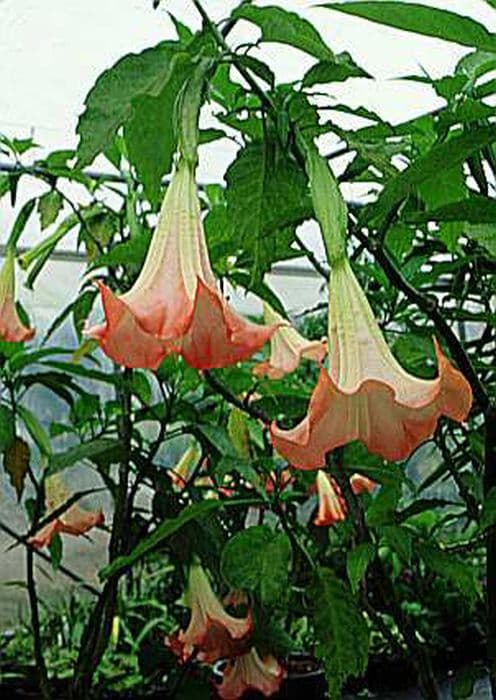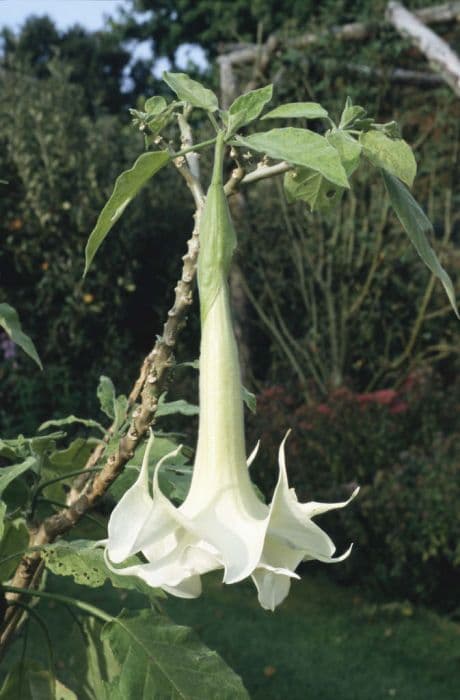Apple of Peru Nicandra physalodes

ABOUT
The plant commonly referred to as apple of Peru is an interesting species with a distinctive appearance. It has a robust, branching stem and large, broad leaves that are heart-shaped with pronounced veins and a somewhat wrinkled texture. The leaves create a lush canopy, giving the plant a full and robust look. The flowers of apple of Peru are bell-shaped, with a delicate and slightly flared mouth, typically showcasing a color palette that includes shades of violet-blue and lighter purple. These blooms are singular and notable for their striking contrast against the green foliage. Following the flowers, the plant produces a fruit closely enveloped by an inflated, papery husk that resembles a lantern in shape. The husk is initially green, but as it matures, it transforms into a light brown or tan color. Inside this husk is a berry-like fruit that is round and contains several seeds. The overall appearance of the apple of Peru is quite distinctive and ornamental, with its combination of heart-shaped leaves, attractive flowers, and lantern-like fruit husks. It has a whimsical and appealing look that can capture the attention in any setting where it is grown.
About this plant
 Names
NamesSynonyms
Apple Of Peru, Shoofly Plant, Peruvian Bluebell, Wild Petunia
Common names
Atropa physalodes, Boberella nicandra, Nicandra adansonii, Nicandra bicolor, Nicandra bonplandii, Nicandra laevis, Nicandra physalodina, Nicandra undulata, Physalis daturifolia, Physalis elegans, Physalis laevis, Physalis nicandra, Physalis peruviana.
 Toxicity
ToxicityTo humans
The common name for Nicandra physalodes is apple of Peru. This plant contains toxic alkaloids and is considered poisonous to humans. If ingested, the alkaloids can cause symptoms such as nausea, vomiting, abdominal pain, diarrhea, and dizziness. In severe cases, ingestion could lead to more serious consequences such as respiratory problems or cardiac effects. It is advisable to avoid eating any part of this plant.
To pets
Apple of Peru is toxic to pets as well. Similar to humans, the plant contains alkaloids that can be harmful if ingested. Symptoms of poisoning in pets might include vomiting, diarrhea, drooling, lethargy, and in severe cases, seizures or heart problems. It is important to prevent pets from ingesting any part of the plant to avoid these toxic effects.
 Characteristics
CharacteristicsLife cycle
Annuals
Foliage type
Deciduous
Color of leaves
Green
Flower color
Blue
Height
3 feet 0.91 meters
Spread
2 feet 0.61 meters
Plant type
Herb
Hardiness zones
Varies
Native area
Peru
Benefits
 General Benefits
General Benefits- Ornamental value: Nicandra physalodes, commonly known as shoo-fly plant, has attractive bell-shaped flowers and lantern-like seed pods that can add aesthetic appeal to gardens.
- Insect repellant: The plant is believed to repel certain insects, which makes it useful for planting in gardens as a natural pest deterrent.
- Easy to grow: Shoo-fly plant is known for being easy to maintain, as it can grow in a variety of soil conditions and is relatively drought-tolerant.
- Self-seeding: It readily self-seeds, ensuring its presence in the garden year after year with little effort on the gardener's part.
- Companion planting: Shoo-fly plant can be used in companion planting to help protect vulnerable crops from insect pests.
 Medical Properties
Medical Properties- Antibacterial: Nicandra physalodes has shown antibacterial activity against certain pathogens.
- Anti-inflammatory: Some compounds in the plant have been reported to possess anti-inflammatory properties.
- Insecticidal: While not directly a medical property for humans, the plant has been used to repel or kill insects that can transmit diseases to humans or livestock.
- Diuretic: Traditionally, it might have been used as a diuretic to help with the elimination of fluids from the body.
- Gastrointestinal disorders: There are historical references to its use in treating certain gastrointestinal issues.
 Air-purifying Qualities
Air-purifying QualitiesThis plant is not specifically known for air purifying qualities.
 Other Uses
Other Uses- Nicandra physalodes, commonly known as apple-of-Peru, can be used as a natural dye, producing a range of blue and green hues on fabrics when used in traditional dyeing processes.
- Its seeds have been utilized as beads in jewelry-making due to their unique appearance and hardiness.
- Gardeners sometimes use apple-of-Peru as a trap crop to protect valuable plants because it attracts certain pests, such as whiteflies and aphids, away from other plants.
- The plant is often included in butterfly gardens, as it can serve as a food source for caterpillars and attract a variety of pollinators.
- Some cultures use the dried seed pods of apple-of-Peru for decorative purposes in flower arrangements and crafts for their intricate, lantern-like appearance.
- In rural areas, the plant has been used to create a temporary fencing or hedge as it grows quickly and robustly, effectively marking boundaries or providing privacy.
- The sturdy stalks of mature plants have been repurposed as a raw material for making paper or as fiber in rudimentary textiles.
- Due to its fast growth and dense foliage, apple-of-Peru is sometimes planted for erosion control on banks and slopes that are prone to soil loss.
- Its distinctive pod shape has inspired design elements in fashion and home decor, where the pod's form is printed or embroidered into various items.
- Farmers have used the whole plant as green manure, incorporating it into the soil to improve soil fertility and structure because it decomposes rapidly and adds organic matter.
Interesting Facts
 Feng Shui
Feng ShuiThe Apple of Peru is not used in Feng Shui practice.
 Zodiac Sign Compitability
Zodiac Sign CompitabilityThe Apple of Peru is not used in astrology practice.
 Plant Symbolism
Plant Symbolism- Protection - Nicandra physalodes, commonly known as apple-of-Peru, is often associated with protection due to its believed ability to ward off pests and evil in traditional folklore.
- Isolation - The plant's characteristic of growing in a solitary manner leads to its symbolism of isolation or independence.
- Deception - With its attractive exterior but potentially toxic seeds, apple-of-Peru can symbolize deception, cautioning against judging by appearances.
 Water
WaterThe Apple of Peru should be watered thoroughly, allowing the soil to dry out slightly between waterings. Water it approximately once a week with about 1-2 gallons, depending on the size of the plant and the conditions such as temperature and humidity. It's important not to overwater to prevent root rot. During the growth season in spring and summer, watering frequency may need to increase due to higher temperatures. In winter, reduce watering as the plant's water requirements decrease.
 Light
LightThe Apple of Peru prefers full sun to partial shade. The best spot for the plant is a location where it can receive at least six hours of direct sunlight per day. It thrives in a bright and sunny spot but also can tolerate a bit of shade, especially in the hottest part of the day.
 Temperature
TemperatureThe Apple of Peru fares best in temperatures between 50 to 86 degrees Fahrenheit. It can survive minimum temperatures down to about 40 degrees Fahrenheit but will suffer if the temperature dips below this point. The ideal temperature range for optimal growth is between 60 to 75 degrees Fahrenheit.
 Pruning
PruningPruning the Apple of Peru helps maintain its shape and encourages a bushier growth. It should be pruned in the late winter or early spring before new growth starts. Remove any dead or damaged stems, and you can also cut back leggy growth to promote a more compact plant. Pruning is typically done once a year, but deadheading spent flowers can be done regularly during the blooming season to encourage more blooms.
 Cleaning
CleaningAs needed
 Soil
SoilThe Apple of Peru prefers well-draining soil with a pH ranging from slightly acidic to neutral (6.0-7.0). A mix of loam, compost, and sand is ideal to ensure adequate drainage and fertility.
 Repotting
RepottingApple of Peru should be repotted every year or two to provide fresh soil and extra space for growing roots, or when it outgrows its current pot.
 Humidity & Misting
Humidity & MistingApple of Peru tolerates a wide range of humidity levels but thrives best in moderate humidity, avoiding extremely dry or overly damp conditions.
 Suitable locations
Suitable locationsIndoor
Pot Apple of Peru in well-draining soil, place in bright, indirect light.
Outdoor
Plant in full sun to partial shade, in well-drained soil.
Hardiness zone
3-10 USDA
 Life cycle
Life cycleNicandra physalodes, commonly known as the shoo-fly plant, begins its life cycle from a seed, which under suitable conditions of warmth and moisture, germinates to form a small seedling. The seedling develops true leaves and undergoes vegetative growth, forming a robust stem and a foliage of large, coarse leaves that are heart-shaped and have a purplish tinge underneath. As the plant matures, it produces flowers that are bell-shaped, usually blue with a white throat, which are followed by the development of distinctive, inflated, lantern-like seed pods that enclose the fruit. After pollination, the seeds develop within these pods; when the pods dry out, they release the seeds, thus completing the reproductive stage. The shoo-fly plant is an annual, completing its whole life cycle—from germination to seed production—within a single growing season, after which the plant typically dies. The released seeds may then lie dormant in the soil until the following spring, when they germinate and the cycle begins anew.
 Propogation
PropogationPropogation time
Spring to summer
The most common common name for Nicandra physalodes is shoo-fly plant. This plant is typically propagated through seed. Propagation by seed generally takes place in the spring after the last frost has passed when soil temperatures have reliably warmed. To propagate, seeds are sown directly into a well-draining soil mix at a shallow depth, about 1/4 inch (around 6 millimeters), and spaced a couple of inches apart to allow for seedling growth. The soil should be kept moist but not waterlogged to facilitate germination. Germination usually occurs within two to three weeks. Once the seedlings have developed several true leaves and are sturdy enough, they can be transplanted to their final location in the garden.


![Calibrachoa [Aloha Classic Blue Sky]](/_next/image?url=https%3A%2F%2Fplants-admin.emdemapps.com%2Fimages%2Fplants%2F%2Fimages%2F604b636c3778b.png&w=640&q=75)
![Calibrachoa [Aloha Classic Gold]](/_next/image?url=https%3A%2F%2Fplants-admin.emdemapps.com%2Fimages%2Fplants%2F%2Fimages%2F604b6284c573e.png&w=640&q=75)
![Calibrachoa [Aloha Classic Tiki Soft Pink]](/_next/image?url=https%3A%2F%2Fplants-admin.emdemapps.com%2Fimages%2Fplants%2F%2Fimages%2F604b548e0a5ef.png&w=640&q=75)
![Calibrachoa [Cabaret Deep Yellow]](/_next/image?url=https%3A%2F%2Fplants-admin.emdemapps.com%2Fimages%2Fplants%2F%2Fimages%2F604b5f20ca3ef.png&w=640&q=75)
![Calibrachoa [Calibasket Radiant Orange]](/_next/image?url=https%3A%2F%2Fplants-admin.emdemapps.com%2Fimages%2Fplants%2F%2Fimages%2F604b536d43cb2.png&w=640&q=75)
![Calibrachoa [Caloha Classic Blue Velvet]](/_next/image?url=https%3A%2F%2Fplants-admin.emdemapps.com%2Fimages%2Fplants%2F%2Fimages%2F604b604884a75.png&w=640&q=75)
![Calibrachoa [Caloha Classic Honey White]](/_next/image?url=https%3A%2F%2Fplants-admin.emdemapps.com%2Fimages%2Fplants%2F%2Fimages%2F604b5f56e0beb.png&w=640&q=75)
![Calibrachoa [Caloha Classic Yellow Chocolate Ring]](/_next/image?url=https%3A%2F%2Fplants-admin.emdemapps.com%2Fimages%2Fplants%2F%2Fimages%2F604b538aede95.png&w=640&q=75)